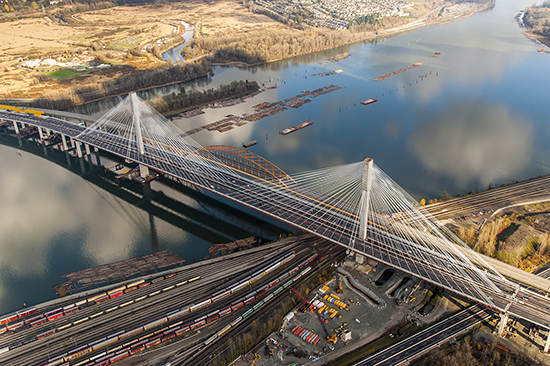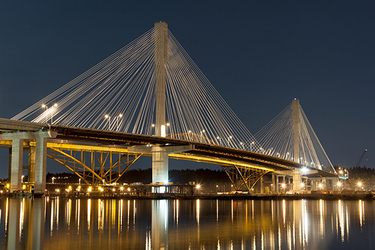|
Subscribe / Renew |
|
|
Contact Us |
|
| ► Subscribe to our Free Weekly Newsletter | |
| home | Welcome, sign in or click here to subscribe. | login |
Construction
| |
 |
January 25, 2016
National finalist: Platinum award
Structural systems
T.Y. Lin International

Project: Port Mann Bridge/Highway 1
Client: Transportation Investment Corp.

T.Y. Lin International was the chief design engineer and project design manager for the Port Mann Bridge replacement in British Columbia.
The project involved construction of a new cable-stayed bridge and improvements to Highway 1. It is the largest transportation infrastructure project in the province’s history.
T.Y. Lin International worked closely with the contractor, Kiewit-Flatiron Partnership, and the project owner, Transportation Investment Corp., to build the new bridge.
The Port Mann Bridge replaces an older, inefficient structure. The design-build project includes the 10-lane, 2,789-foot-long bridge crossing the Fraser River, plus a 1,148-foot-long south approach and a 2,690-foot-long north approach. Its 1,542-foot-long main span, 623-foot-long side spans, and 171-foot-wide deck make the bridge the largest main span crossing in Western Canada, North America’s second-longest cable-stayed bridge, and one of the world’s widest bridges.
The bridge has two separate five-lane deck structures supported by a single central pylon, and the twin decks are separated by a 33-foot median where two distinctive, 535-foot-high single-mast concrete towers as well as the central pylons are located. This superstructure supports 10 lanes instead of the five lanes originally envisioned. There also is a barrier-separated, 10-foot-wide bicycle/pedestrian path on the east flank.
The Port Mann Bridge opened in two phases. Phase 1 included eight traffic lanes and opened a year earlier than planned. Phase 2 opened the final two lanes and the multi-use path. The project was completed on time and on budget in August 2015.
The Port Mann Bridge now helps reduce travel time for drivers by as much as 50 percent, or up to one hour of drive time each day. The value of the anticipated travel time and operating cost savings is estimated to have a present value of more than $5 billion Canadian over a 35-year operating period. The bridge also introduces new transportation alternatives, including transit, cycling and walking.
Greg Johnson of owner Transportation Investment Corp. commended T.Y. Lin International “for their outstanding work on the seismically resilient, visually stunning bridge … The success of this project was made possible in large part by the intensive, positive coordination and collaboration that took place throughout the life of the project.”
Other Stories:
- National finalist: Gold award
Energy
DLR Group - National finalist: Gold award
Structural systems
HNTB - National finalist: Gold award
Waste and stormwater
Parametrix - National finalist: Gold award
Water resources
Parametrix - Best in state: Gold award
Unique or innovative applications
DCI Engineers - Best in state: Gold award
Future value to engineering profession
GeoEngineers - Best in state: Gold award
Successful fulfillment of client/owner needs
Osborn Consulting - Best in state: Gold award
Social, economic and sustainable design
Otak - Best in state: Gold award/Special judges award
Complexity
KPFF Consulting Engineers


